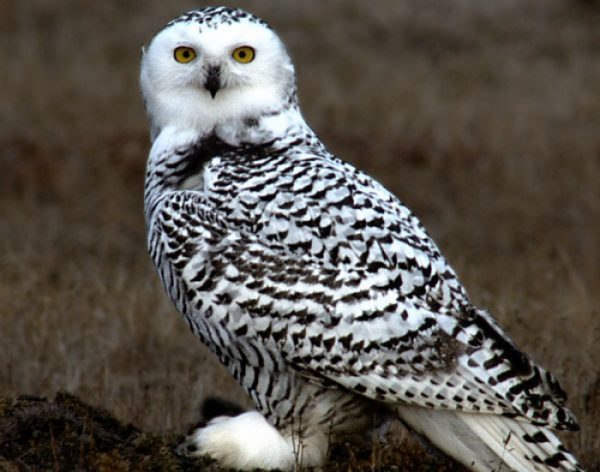Snowy owl invasion

As I write this article, temperatures are forecast to be in the low 70s later this week, so it’s unlikely we’ll have a white Christmas this year. While the arrival of significant winter weather is always questionable in North Carolina, an occasional white coating is not uncommon. Although you probably won’t see any snow for your holiday parties this year, if you get outside you might be lucky enough to see something even rarer – a snowy owl.
Snowy Owls (Bubo scandiacus) are the largest North American owl, and typically spend their summers north of the Arctic Circle. These owls are unmistakable – with their large size, snow-white plumage, black beak, round head, and bright yellow eyes. Males are pure white, females have some dark spots, while juveniles have more dark colored barring (see photo above).
Snowy owls nest on the ground, and they can be quite territorial. Both the mother and father are known to defend the nest by diving and attacking predators, or performing displays to distract them. They eat lemmings and other rodents, as well as small mammals such as squirrels and rabbits. They also prey on birds, including ptarmigans, ducks, geese, songbirds, and even other raptors. They are a diurnal hunter, and in their arctic habitat, continuous daylight means they can be found hunting at all hours of the day.
This has been a record year for snowy owls, especially in eastern North America, with sightings as far south as North Carolina, and one bird even spotted in Bermuda. Though usually found in the arctic tundra, typically above 60 degrees latitude in the northern hemisphere (in places such as Alaska, Canada and Eurasia), they are also known to be an occasionally nomadic bird. In some years they will spend the entire year in their northern breeding grounds, while in others they can be more erratic, appearing much farther south. So far, this winter has been exceptional in terms of sightings; following a similar pattern two winters ago (2011-12) when large numbers of snowy owls also migrated southward.
The reason for what some are calling a ‘snowy owl invasion’ this year is not entirely known, but this cyclical irruption has been known to occur for centuries. Their range and presence is believed to be closely tied to the population dynamics of its prey. In years of abundant prey, snowy owls are known to raise lots of young, only to skip raising young entirely in leaner years. So an abundance of lemmings one year, resulting in a really successful season of raising broods, may have the consequence of placing greater stresses on the prey supply the following year, sending many owls farther south in search of food. Additionally, snowy owls are known to have the ability to travel great distances, which makes these long migrations possible in the first place.
Snowy owls prefer open areas, such as coastal dunes and prairies, and unfortunately have become a problem for some airports because they provide large open grasslands where snowy owls can hunt. The loss of naturally-occurring, native grasslands, and the prey species found in them, may be further stressing this species.
Like other birds, the behavior patterns and population dynamics of snowy owls may be telling us something about the environmental conditions surrounding them. Climate change, especially relating to their arctic habitat and including the loss of sea ice, may be having an effect on their range and prey distribution as well.
While mass southern migrations of snowy owls have been known to occur for centuries, this year’s is one of the more dramatic. You can report snowy owl sightings on ebird.com, and help add to the information database maintained by ornithologists so that they can gain a better understanding of their unusual habits and habitats in regards to changing environments.
Just as we rarely know what to expect when it comes to snow in North Carolina, changing temperatures can bring unexpected species to our state as well. Seeing a snowy owl, or his smaller cousin the barn owl (which I have been fortunate enough to spot twice in Montgomery County), is a lucky encounter, and would be a great and unexpected holiday gift for any birdwatcher – certainly one I’d prefer over actual snow anyway. Whatever your holiday wishes are this year, here’s hoping they come true. Happy holidays!